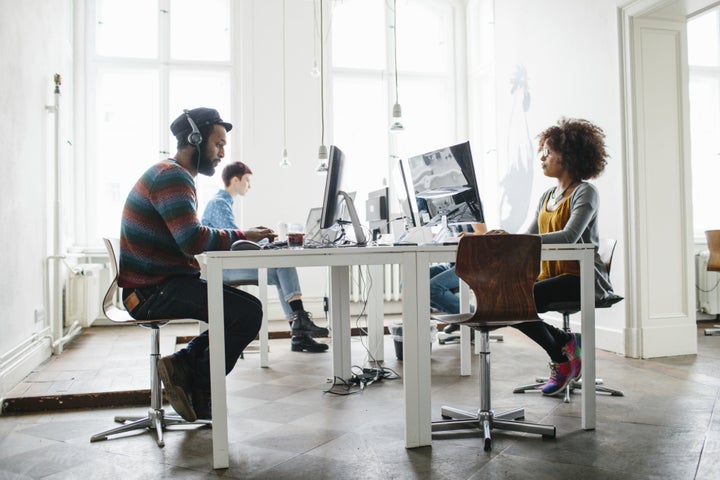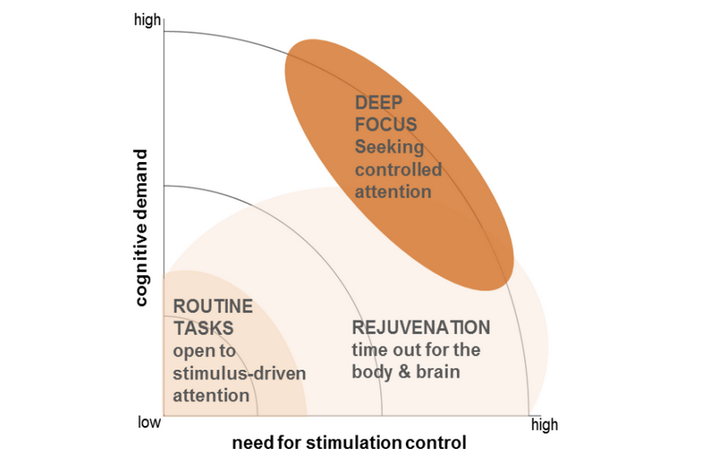
One morning last week, I arrived at my desk -- one of the hundreds arranged in long rows throughout the Huffington Post newsroom -- and instinctively took out my earbuds.
"What kind of music do you listen to?" my coworker Alex asked me.
I hadn't had enough coffee that morning and I was confused (also I'm perpetually afraid of not liking the "right" music because I'm 26 but still in high school).
"What? Why?" I asked.
Alex explained that he always saw me with my earbuds in, so he assumed I was really into music. Oh. In reality, I often have earbuds in with nothing playing, or some random Spotify radio station I don't really care about. I listen to the kind of music that functions as white noise to cut out the voices of the dozens of people around me.
In a big open newsroom, cutting out the sound around me is my favorite way to construct imagined private space where none exists.
Here's the thing: The open plan, itself, is not really the problem. Office design experts now think that you need elements of an open plan as well as closed private offices to encourage people to produce their best work. The key is recognizing that employees have different working styles that require different types of spaces. Often, what the same person needs in the workplace varies from one task to the next.
The office of the future has both open and private spaces. It has spaces where two people can have a quiet conversation, spaces for people to do highly focused work and lots of open areas where creativity and innovation can thrive. The office of the future is about giving workers both flexibility and agency.
"What has happened [to the workplace] is it has gone from a real estate discussion... to becoming more of a people-centric discussion," said Tracy Wymer, the director of workplace strategy at Knoll, the office design firm. And people, it turns out, need privacy sometimes.

The open office has been around for decades. In fact, the cubicle was designed in the 1960s by the American inventor Robert Propst, who was attempting to solve many of the privacy issues that arose from open offices back then. But Propst's design backfired as, by the 1990s, "the flimsy walls of the cubicle began to symbolize not independence and flexibility, as Propst had hoped, but transience, precariousness and the disposability of the American worker," according to Nikal Saval, who wrote a book on the history of the office space.
The early 2000s, then, saw the dawn of the new era of the open office. Not only does an open plan free workers from their cubes, it also frees up valuable real estate. After the Great Recession, converting to an open plan allowed companies to put more employees in smaller spaces, making overhead cheaper.
In 2009, when Goldman Sachs moved to its newly built office at 200 West Street in lower Manhattan, the company wrote in its environmental progress report that it improved "space utilization through workplace standards and increased occupancy rates." In other words, they put more workers in a smaller space (the previous year, if you remember, was not Wall Street's greatest).
Part of that is simple consolidation: the new building combined what had been two different campuses, so they naturally reduced some common areas. But it also moved everyone below the managing director rank into an open office environment.
And then, a few years after that, came the great backlash.

"There was chatter on the web questioning the value of open plan and constant collaboration," said Melanie Redman, a senior design researcher at the furniture company Steelcase. "We felt the need to respond to that."
And these weren't just empty complaints. The team detected a "deeper level of angst" about open offices than they expected, Redman said, and they wanted to learn more about it.
It turns out my headphones-on-with-nothing-playing trick is one of the most common reactions to working in an open office, she said.
After the company's research team spent time studying privacy in the workplace around the world, they found that it's "a basic fundamental human need," said Redman. No matter the company or the culture, almost every employee desires privacy for one of two reasons: they either want to control the stimuli coming in to their environment or they want to control the information they are projecting out to the people around them.
An open plan office can be annoying because your coworkers come and interrupt you every five minutes, or it can be annoying because your boss can see what you are doing every moment of the day. Either way, the solution is more private spaces.
It's no surprise that American office drones workers largely despise open office plans.
"It's important to me to give my (albeit small) staff a sense of having their own space, and I absolutely would be discouraged from taking a job with an open plan," said Randy Locklair, the owner of Hatchmap, a software development company. "I really despise the feeling of having people sneaking up on me at work," he added.
Lucia Deng, a mid-career lawyer who has recently been on the job market, told me, "When I was interviewing at a startup, I saw that their lawyers worked in an entirely open space and on communal tables and the thought of that gave me agita!"

I should probably say that the Huffington Post newsroom, despite the silent headphones many people use, is actually an example of the kind of open office plan that can work. Though there is a cavernous open room, there are also various different kinds of breakout spaces: tiny single-person phone rooms, medium-sized huddle rooms and big conference rooms that can be reserved, in addition to various couches and tables strewn through the common spaces of headquarters.
The key is flexibility.
"The big picture is that there is no one-size-fits-all [workspace]," Redman said. "We can’t predict what people are going to need. Open plan only works if workers have the permission to move and a place to move to."
The question is not whether we need privacy in our office spaces. The question is how to configure the space so that workers can move to the right type of environment for whatever task they happen to be working on. Steelcase has designed several different kind of "enclaves." The company says "highly differentiated settings ensure that users can choose their best place based on task, mood and personality, making the experience of privacy personal."

It turns out that coworking spaces -- which generally are in the business of designing office space so that either individuals or small companies want to rent it out -- are getting this right more than most. In a Harvard Business Review article from September about why those who work in coworking spaces tend to be more productive than the average worker, a group of researchers from the University of Michigan write that being connected to a community at work is important, but a successful workspace has a mix of different kinds of spaces:
In reality, people need to be able to craft their work in ways that give them purpose and meaning. They should be given control and flexibility in their work environment -- many companies are increasingly adopting the best planning practice of providing a 1:1 ratio (or close to it) of desk seats to seats in shared settings used for either collaborative work or quiet work.
There are a lot of moving parts to the theory of office design, according to Wymer. Workspaces are starting to borrow design theory from hotels, he said. "There is a notion of hospitality, a notion of theater and there’s a certain notion of play that gets involved. A lot of boundaries are really getting blurred at this point."
And then there are the people who are still creating completely open offices, because it works for them. Kyle Chayka just opened a new coworking space with a group of writers in Brooklyn in September. They did a gut renovation and chose to keep the office open so they could communicate better and be helpful to each other throughout the day.
"Having an open office without different little private areas, people are more aware of each other -- that is useful for us since we are all journalists," Chayka said.
Of course, in an office for freelancers, the solution to needing privacy at work is just staying at home.
